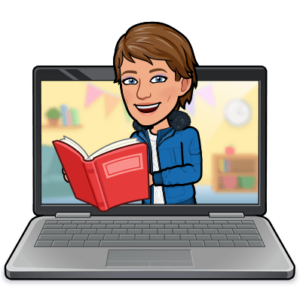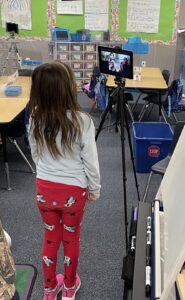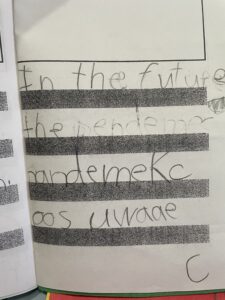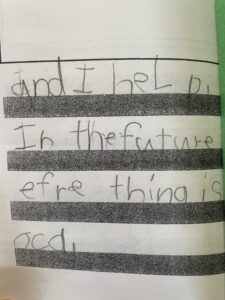Adaptations – Teaching in the 2020-2021 School Year, Part 3: TECH AND TEACHING FLEXIBILITY
Welcome to part three of my blog series on teaching for biliteracy during a pandemic! As you’ve likely begun settling into some changes, perhaps you have some thoughts on Technology and ways you’ve incorporated additional Teaching Flexibility.
Technology. Wow. I think about what would have happened if we experienced this pandemic when I was in elementary school in the 1980s. It would have given a whole new meaning to parents as teachers! We are so lucky to have the ability to continue to teach our students remotely and provide them direct services if they have the technology on their end as well.
Virtual classrooms

Installing Bitmoji as an extension on my computer’s URL bar made it easy for me to find a Bitmoji image to add to each week’s virtual classroom. Managing your character (such as changing hair or outfits) must happen on the Bitmoji app on your phone, however.
Bitmoji teacher? How cool is that? Links to books, videos, virtual field trips, songs for movement breaks, and so much more! Our virtual classrooms have become a great tool for families to have a window into what our class is learning throughout the week. We can provide the charts our students need for visual aids or for our TPRs. It takes time to build a virtual classroom, but the benefits for our distance learners make it worth it. Linked here is a sample virtual classroom from my teaching partner, Bebi. I shared one of mine in the Part 2 Blog of this series.
Learning platform
We are using Zoom as our platform for teaching distance learners. Some schools are using Microsoft Teams, and I know there are many other ways to connect virtually with students and families. Regardless of the platform, many of the ways we are interacting that I describe below can be applied if it works for you. I would love to hear your suggestions and tech hacks as well!
The digital classroom learning curve has been steep but we are definitely improving. On a daily basis, we set up an iPad as well as our computer. On the computer, we use the app ImageMate to project to our distance learners anything that we have on our ELMO document camera for kids at school to see. We share our screen so that students at school can see the faces of distance learners as well as the computer content. We set up an iPad on a tripod (but do not connect to audio so that we don’t get feedback) so that students at home can see their classmates learning at the same time as they are. The tripod is the one “student” that no one has to stay socially distanced from!
We include our distance learners in everything we can. When it is time for guided reading groups, we message their parents to log on to Zoom again and join their group mates. When a schedule change occurs last minute, we send messages to inform the distance learning families so they do not miss out on instruction. It is so important for those distance learners to feel connected. I often stay on the computer with them during recess for an extra minute or two so that they can share a story from their weekend and connect with me on a personal level. Sometimes they request to stay on together after class so that they can just talk with each other! They crave that togetherness.
We’ve had to be on top of every moment in our day more than ever, and I want you to know that juggling both in person learners and distance learners is no simple feat. There are daily frustrations with technology not working on one end or the other, missing materials, schedule changes/interruptions, and teachable moments that throw the day off course. For all of that we must remember to be flexible and go with the flow. Be forgiving to yourself and others and it will all work out in the end. The most important things is that all of our students, whether they are learning in-person or on the computer, feel connected, respected, and part of the class community.
Phonics and Face Masks
Teaching during a pandemic has implications beyond just having students on a computer. Our district protocol is that a mask must be worn at all times, and a face shield may be worn in addition, but not in place of, a mask. Ugh. I understand the safety reasons, but how am I supposed to teach phonics?
Me to the Kindergarten class last fall: “Boys and girls, the letter f says /f/. Imagine my top teeth tickling my bottom lip as I blow air from my mouth…/f/, /f/.” Not going to work. They need to see it.
I tried the transparent masks of many different varieties. They stuck to my face or filled with condensation. They muffled my voice. They did not solve the issue of being able to effectively teach phonics. As a result, I made a professional decision.
As long as I was socially distanced from my students, I felt it was safe AND necessary to perform the duties of my job to temporarily wear a face shield only. I only wear it during phonics instruction and during some read alouds when facial expression is such a key part of the story. Because these lessons are typically less than 15 minutes and I can ensure proper distancing, I feel I am doing the professionally responsible thing by allowing my students to see my mouth. If we can be in the same room eating lunch without masks on for 15 minutes a day, teaching phonics with a face shield only for less than 15 minutes seems even less of a risk. In addition, our speech pathologists have permission to wear face shields only during some of their instruction, so I consider my job of teaching phonics to warrant that same exemption for short periods of time.
You will want to weigh your own risks and level of comfort, but I hope you remember that even when something feels like it is set in stone, take the time to step back, examine it, and see if there is another way to approach the issue. You may consider making gifs of yourself saying the sounds or pre-recording yourself on video to show your students. This would take some advanced planning but it would also be the safest option for everyone. You may want to check out this link to our free webinar on setting up virtual DL, which includes more information on Bitmoji classrooms and on creating gifs.
Touch
At the beginning of the school year, I did not touch our children at all. I watched as shoe laces dragged across the ground, untied, as I was instructed not to touch. Jacket and backpack zippers were fumbled with and, in many cases, left untouched by students out of frustration. Children I loved and cared for stretched out their arms for a hug, and I responded with a wave. My afternoon goodbyes, once a choice of handshake, high-five, or hug (pre-pandemic), turned into a call and response of me saying “See you later alligator!” and the responding “After a while, crocodile!” My heart hurt.
Then I realized something: Kids need touch. And so do adults. Connection is powerful. They can’t see my smile, so they must feel my love somehow.
This January, I started touching my students’ backs. Just a hand on their back, as I used to always do to help calm a frustrated learner, refocus an off-task student, or let a child know I care. That simple touch came back to my classroom and it has made all the difference in the world.
Please keep in mind, I wash my hands and use hand sanitizer what feels like CONSTANTLY throughout the day. I wear a mask. I do not stay close for long, but just enough for them to know I’m there. I do everything in my control to safely interact with my students, and it is so healing for all of us. I can see them smile through their eyes and school once again feels like a place where they are loved, not a scary institution with a laundry list of rules and a teacher with only eyes and no smile. They do not touch their own backs and nor does much else, so to me it is the safest place to have that human interaction.
I’d like to leave you with an excerpt from one of my first grader’s autobiographies, which he completed last week:
If that’s not enough to settle your mind, please accept this distanced air hug! Come back again soon for one final entry to my Teaching 2020-2021 blog series: PATIENCE.




